If you’re planning to camp in Canyon de Chelly, you’ll want practical info on permits, campsites, and guided backcountry access. You’ll learn which rim sites offer amenities, when the weather’s best, and why you must hire a Navajo guide for canyon trips. Get prepared with the right gear, water, and etiquette to respect living cultural sites — and know what to expect before you commit to an overnight.
Why Canyon De Chelly Is a Unique Camping Destination
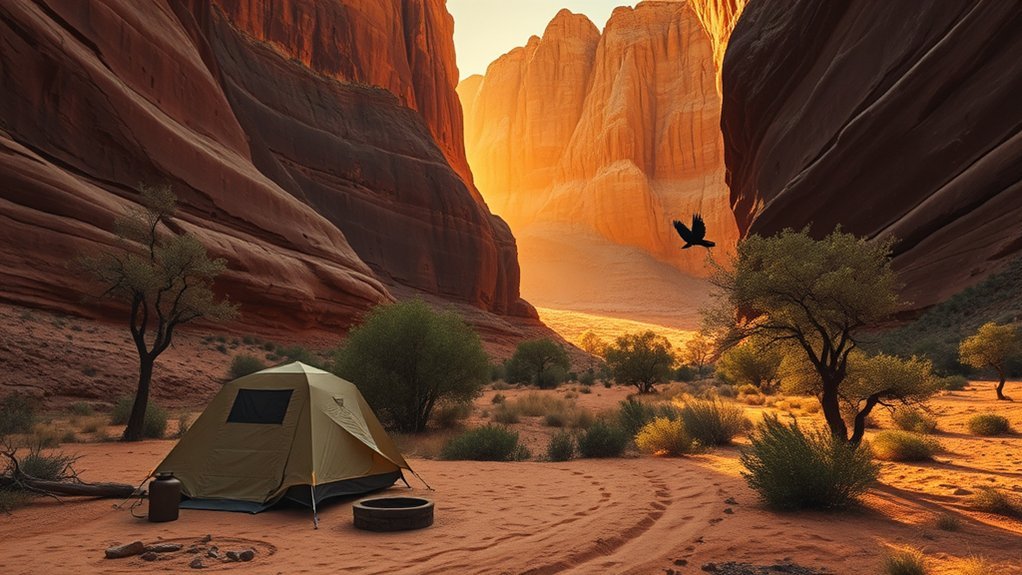
Because Canyon de Chelly blends dramatic sandstone cliffs, living Navajo communities, and well-preserved archaeological sites, camping here feels more like a cultural and natural immersion than a typical park stay. You’ll camp at Cottonwood Campground for easy access to canyon overlooks and a quieter, scenic base. Unlike many public parks, backcountry camping in Canyon De Chelly National requires a local guide, so overnight trips become safe, respectful, and informative—guides handle permits, routes, and cultural context. You can hike unguided only to places like the White House ruins, so plan those visits separately. Pack layered clothing, water purification, and respectful questions for hosts. This setup preserves archaeological sites while giving you direct connections to landscape and Navajo traditions.
When to Visit: Best Seasons and Weather Considerations
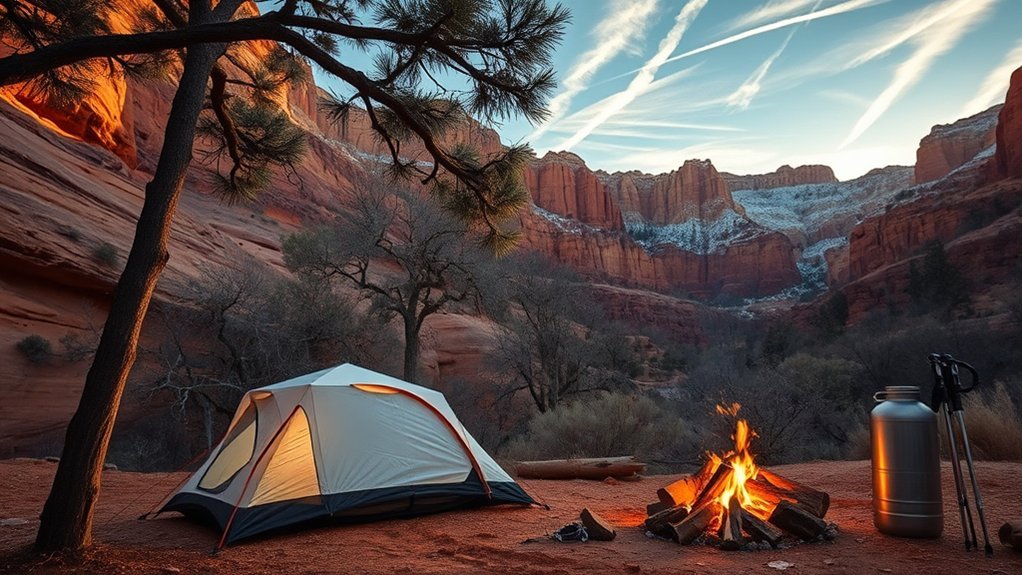
If you want the most comfortable weather and smaller crowds, plan your trip for spring (March–May) or fall (September–October); temperatures are mild, trails are more pleasant, and reservations are easier to secure. Those best seasons avoid summer heat—averages near 90°F—when you’ll hike early or late. Expect summer monsoons (July–September) and pack rain gear. Winters get cold; January highs can drop toward 40°F, so layer up. Check forecasts and book campsites early in peak windows.
| Season | Typical Temps | Tip |
|---|---|---|
| Spring | Mild | Great wildflowers |
| Summer | Hot, stormy | Hike early/late |
| Fall | Cool, stable | Prime camping |
| Winter | Cold | Bring layers |
Understanding Access Rules and Navajo Nation Permits
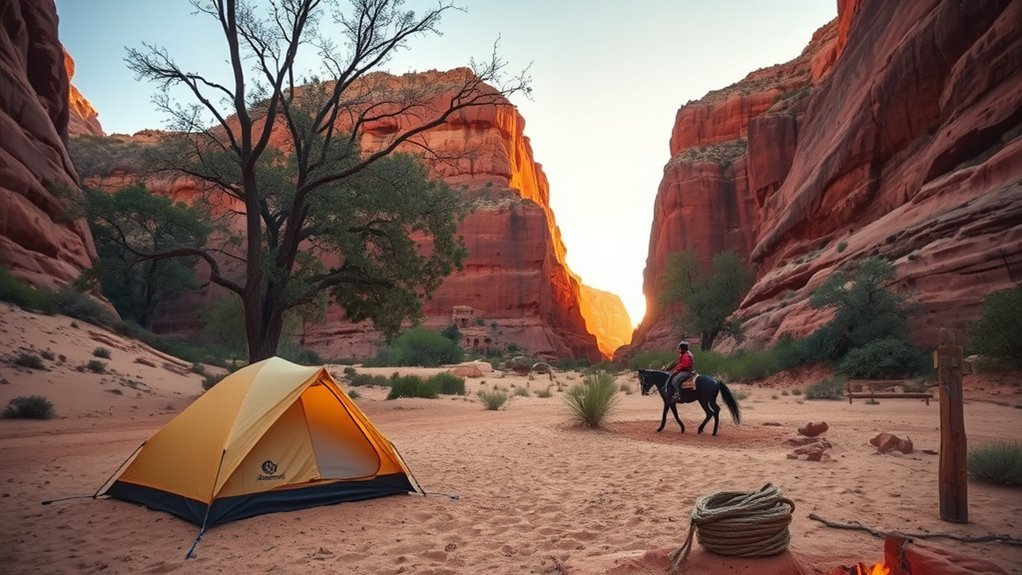
You’ll need to obtain Navajo Nation permits for camping and certain activities, because Canyon de Chelly isn’t a typical public park and is governed by tribal rules. Remember that most canyon floor access is guided-only—day hikes into the canyon require hiring a local Navajo guide unless you’re visiting designated unguided spots like the White House ruins and rim trails. Check seasonal restrictions and permit procedures with Navajo tribal offices before you go so your trip stays legal and respectful.
Navajo Permit Requirements
One clear rule governs overnight stays at Canyon de Chelly: you must get permission from the Navajo Nation before camping. You’ll contact tribal offices to secure Navajo permit requirements and confirm which established campgrounds are open—there’s no backcountry camping. Day hikes into the canyon usually require a Navajo guide, so verify permit terms for guided access; unguided hiking is limited to the White House ruin and rim trails.
- Call Navajo Nation offices to request camping permits and confirm fees, dates, and campground locations.
- If planning canyon floor hikes beyond the White House, book a licensed Navajo guide and make sure your permit covers guided access.
- Follow all Navajo Nation regulations to camp respectfully and legally.
Guided-Only Canyon Access
After arranging your camping permit with Navajo tribal offices, plan on hiring a licensed Navajo guide for most canyon access—only the White House ruin and rim trails allow unguided hiking. You’ll follow Navajo Nation rules: book guides and permits in advance, use designated campgrounds like Cottonwood or Spider Rock, and respect cultural sites. Guides handle navigation, history, and safety; they’ll also advise on theft risks at trailheads so you’ll secure belongings.
| What to book | Why it matters |
|---|---|
| Licensed Navajo guide | Required for most canyon access |
| Camping permit | Needed for overnight stays |
Plan ahead, confirm guide credentials, and treat Navajo Nation regulations as mandatory — they protect you and the canyon’s cultural landscape.
Where to Stay: Cottonwood and Spider Rock Campgrounds
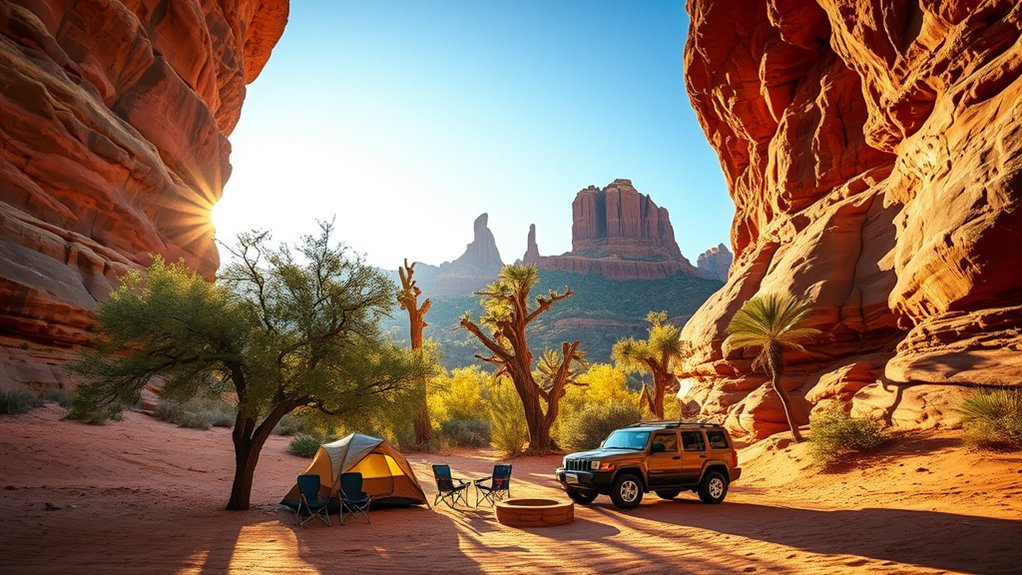
If you want close canyon access and reliable amenities, start with Cottonwood Campground—its tent and RV sites sit near trailheads and offer picnic tables, fire rings, and restrooms for a straightforward stay. You’ll find it practical for day hikes and easy logistics, while Spider Rock Campground on the Tse Ho Tso Plateau delivers quieter nights, tent sites, RV access, and Navajo Hogan rentals for cultural immersion. Both spots are great for stargazing and wildlife viewing; reserve early in peak season.
- Choose Cottonwood Campground for convenience, facilities, and proximity to main trails.
- Pick Spider Rock Campground for solitude, plateau views, and Hogan stays.
- Make reservations ahead to secure sites during busy months.
Booking Local Guides for Canyon Access and Overnight Trips
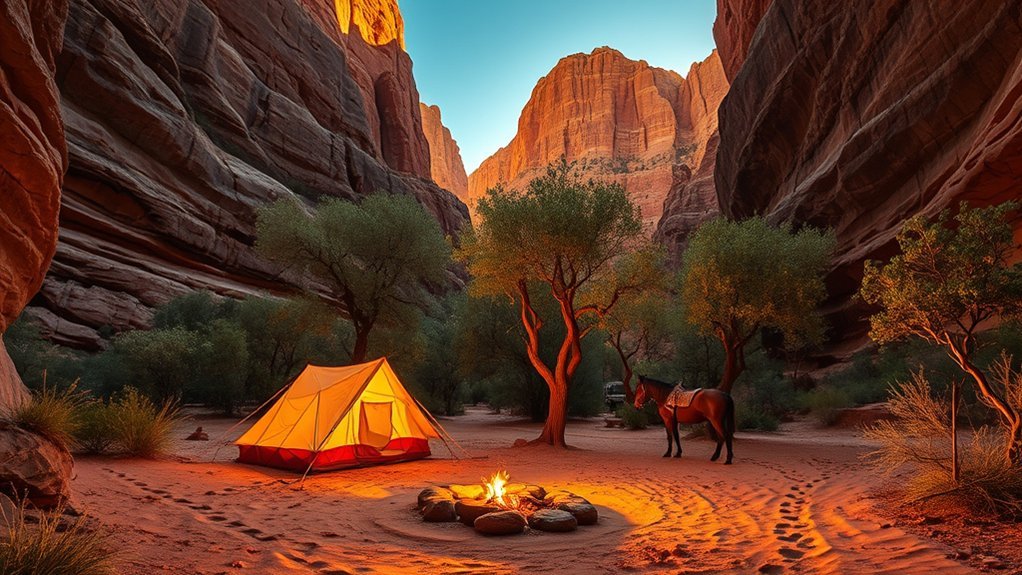
To hike or camp inside Canyon de Chelly you’ll need to hire a local Navajo guide, so start by choosing someone experienced and well-reviewed—Deswood Yazzie comes highly recommended for his knowledge of the canyon’s history and culture. Book guides and any guided overnight trips well in advance, especially in peak season, and confirm that the operator handles tribal camping permissions. If you plan a multi-night backcountry trip (REI and others offer 3-night options at a premium), make sure permits are secured before you go.
Guide Selection Tips
When you’re planning canyon access or an overnight jeep trip, book a knowledgeable local guide well ahead of time—guides like Deswood Yazzie are highly recommended for their expertise and local knowledge. Use these guide selection tips to focus your search: tours into the canyon require guided access, and experienced guides handle Navajo Nation rules and logistics.
- Verify experience: ask about years guiding in Canyon de Chelly, overnight jeep trip experience, and recent trip references.
- Confirm scope: verify the guide offers the specific tours into the canyon you want (day hikes, overnight jeep camping) and knows permitted routes.
- Check communication: confirm scheduling flexibility, cancellation policy, and that they’ll confirm required tribal permissions before your visit.
Booking & Permits
How do you secure a guided hike or overnight stay in Canyon de Chelly? You’ll need to arrange booking with a local Navajo guide—most trails and all overnight camping require one. Contact tribal offices for camping permits and confirm rules; White House Ruin is the lone unguided option. Reserve well ahead, especially for overnight trips.
| What to book | Who to contact |
|---|---|
| Day hikes | Local Navajo guides |
| Overnight camping | Tribal permits + guide |
| White House hike | No guide required |
| Recommended outfitter | Far Out Expeditions (Deswood Yazzie, Vaughn Hadenfeldt) |
Bring permit confirmations, discuss logistics with your guide, and verify cultural/site rules. That guarantees legal, respectful access and a safer, richer experience.
Backcountry Camping Options Through Guided Tours
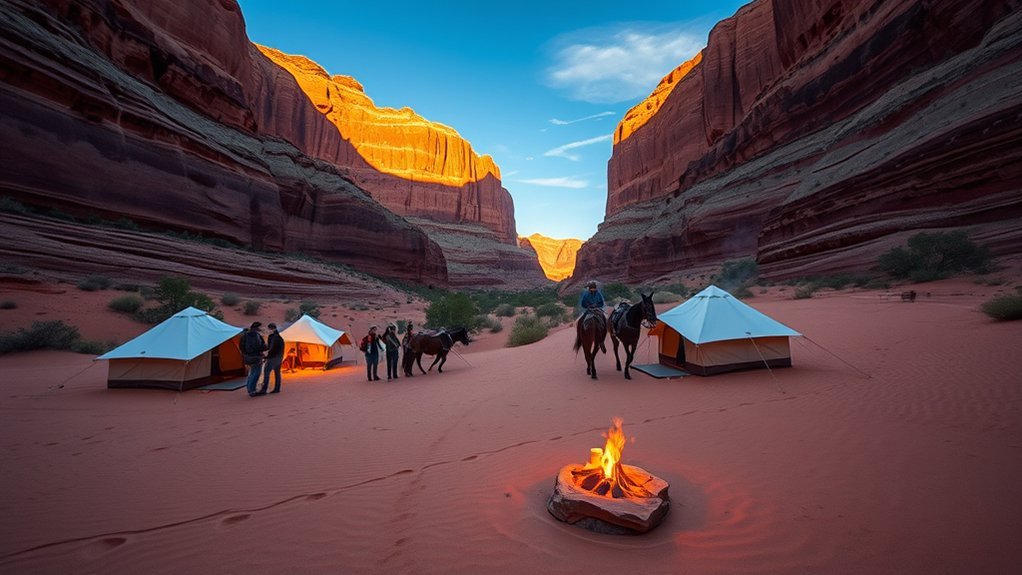
Although you can’t camp in Canyon de Chelly’s backcountry on your own, booking a guided overnight tour with a local Navajo guide lets you experience multi-day hikes, jeep-access camps, and hidden canyon sites while learning about the area’s cultural and historical significance. You’ll rely on authorized guides for backcountry camping; they handle permits, route planning, and safety. Reserve early, especially in spring and fall, because spaces fill fast. Guided tours often provide meals, equipment, and insider knowledge that enrich your stay and respect tribal regulations.
You can’t camp solo in Canyon de Chelly — book a Navajo-guided overnight for multi-day hikes, camps, and cultural insight.
- Multi-day hiking trips — immerse yourself in canyon history with experienced guides.
- Jeep-access camps — reach remote sites with comfortable setups and gear provided.
- Cultural-focused overnights — learn Navajo stories, customs, and landscape stewardship.
Day Hikes and Rim Trails You Can Explore Unguided
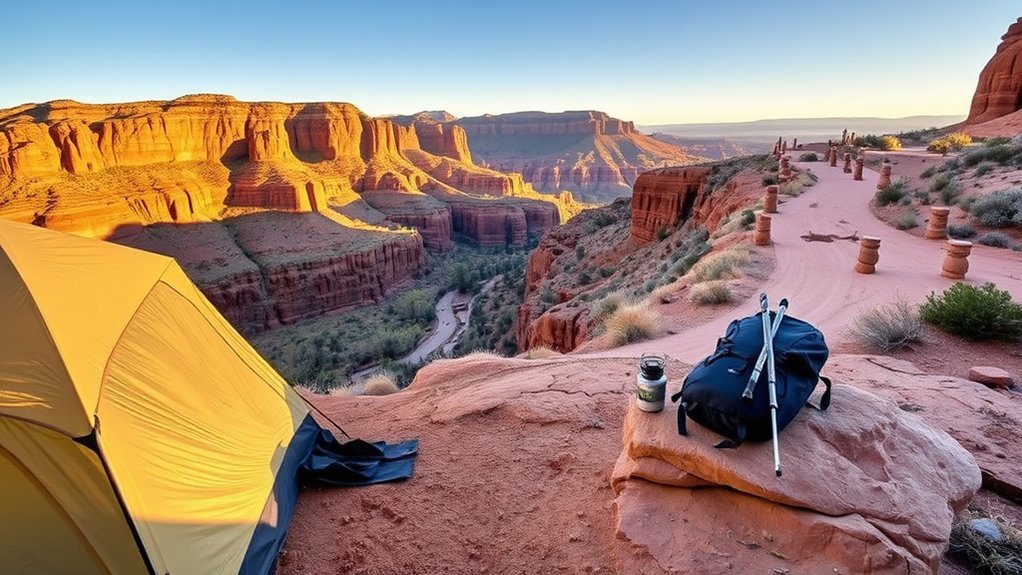
You can hike the 2.7-mile White House Trail on your own to reach impressive cliff dwellings, but remember it’s out-and-back so plan your time. Walk the rim overlooks along Canyon de Chelly Highway and North Rim Drive to hit ten scenic viewpoints and short trails like Tunnel, Bat, White Sands, and Bee Hive without a guide. Stay safe by carrying plenty of water, watching for sudden weather changes, and knowing that any routes down into the canyon require a Navajo guide.
White House Trail Access
The White House Ruin Trail is a 2.7-mile out-and-back hike you can do without a guide, starting at the White House Overlook on the South Rim Drive where parking is available. You’ll descend into the canyon toward the White House ruins, enjoying close-up views of cliff dwellings and canyon walls. Expect a steep, strenuous return; plan water, sun protection, and steady pacing. Check weather and avoid the trail during storms.
- Bring at least 2 liters of water per person and snacks for the climb back.
- Wear sturdy shoes and be ready for loose rock and elevation gain on the return.
- Park at the South rim trailhead; signage marks the route to the ruins.
Rim Overlook Walks
If you liked the close-up experience of the White House Trail, head back up to the rim to explore any of the ten overlooks that need no guide and give sweeping views of the canyon’s geology and cliff dwellings. You can walk short spur trails from parking areas along the Canyon de Chelly Highway loop to Antelope House, Massacre Cave and Spider Rock viewpoints. The North Rim Drive’s 15 miles and the South Rim Drive’s 16 miles concentrate these accessible overlooks, so plan drives and short walks to maximize light and avoid crowds. Remember unguided access is limited to the rim; interior canyon routes require Navajo guides. Carry maps, stay on marked paths, and time visits for cooler morning or late-afternoon conditions.
Safety and Water
When hiking rim trails or tackling the White House Ruin Trail, pack plenty of water and plan for the climb back out—those elevation changes make the return much tougher than the descent. You’ll carry at least a liter per hour in summer, layer for temperature swings, and stash a rain shell. Stay on designated paths to protect ruins and avoid unstable edges. Secure valuables before you start; theft at trailheads happens, so don’t leave gear in plain sight.
- Bring extra water, a filter, and electrolyte options for long outings.
- Check weather, wear sturdy shoes, and prepare for rapid temperature shifts.
- Lock valuables, note vehicle location, and tell someone your route and return time.
Packing List and Safety Tips for Canyon Camping
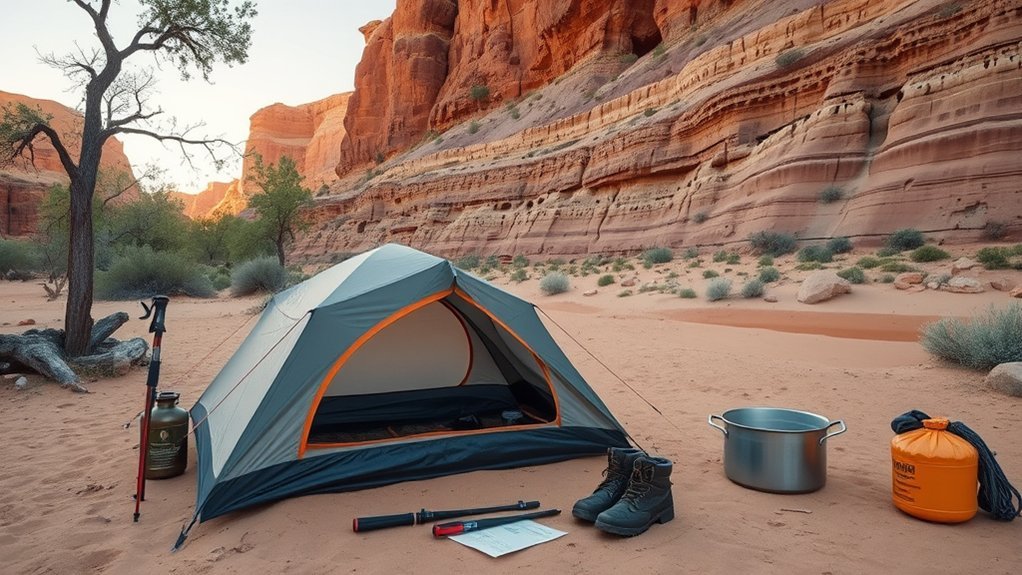
1 smart rule for Canyon de Chelly camping: pack for heat, altitude, and limited services—bring ample water, layered clothing, a sturdy tent and sleeping kit, a thorough first-aid and safety set, and reliable navigation (map or GPS), since trails can be strenuous, temperatures swing wildly, and cell service is often spotty. For practical camping safety tips, carry at least one gallon of water per person per day, electrolyte replacements, and a water filter as backup. Bring a compact, complete first-aid kit, altitude-aware meds, and sun protection. Choose lightweight layers for big diurnal swings and a robust tent for dusty winds. Rely on a physical map plus GPS. Tell someone your plan and expected return; remote rescues take time.
Nearby Navajo Nation Sites Worth Visiting
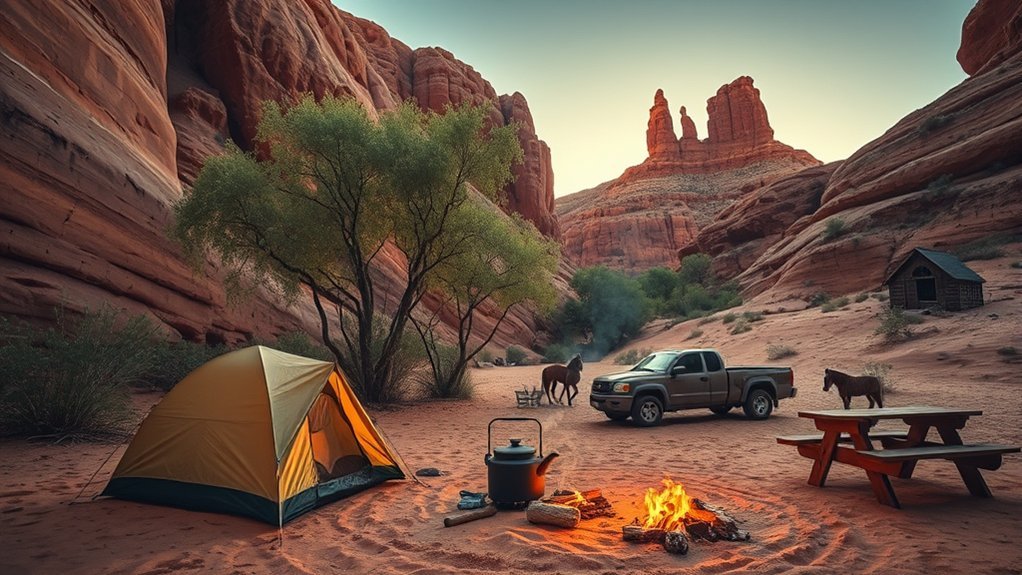
After you’ve got your gear and safety plan sorted for Canyon de Chelly, consider expanding your itinerary to nearby Navajo Nation and ancestral Pueblo sites that reward the extra travel time. You’ll find diverse ruins, guided hikes, and camping options that complement canyon camping without repeating cultural etiquette topics reserved for later.
- Wupatki National Monument — Explore sandstone pueblos and short hikes through volcanic landscapes; it’s great for a half-day detour and photography.
- Navajo National Monument / Keet Seel — Join a ranger-led hike to the cliff dwellings; overnight camping options make this a rugged, memorable extension if you’re fit and prepared.
- Chaco Culture National Historical Park (plus Walnut Canyon, Homolovi nearby) — Visit extensive Puebloan architecture and trails; combine with stargazing and archaeological interpretation.
Respectful Travel Practices and Cultural Etiquette
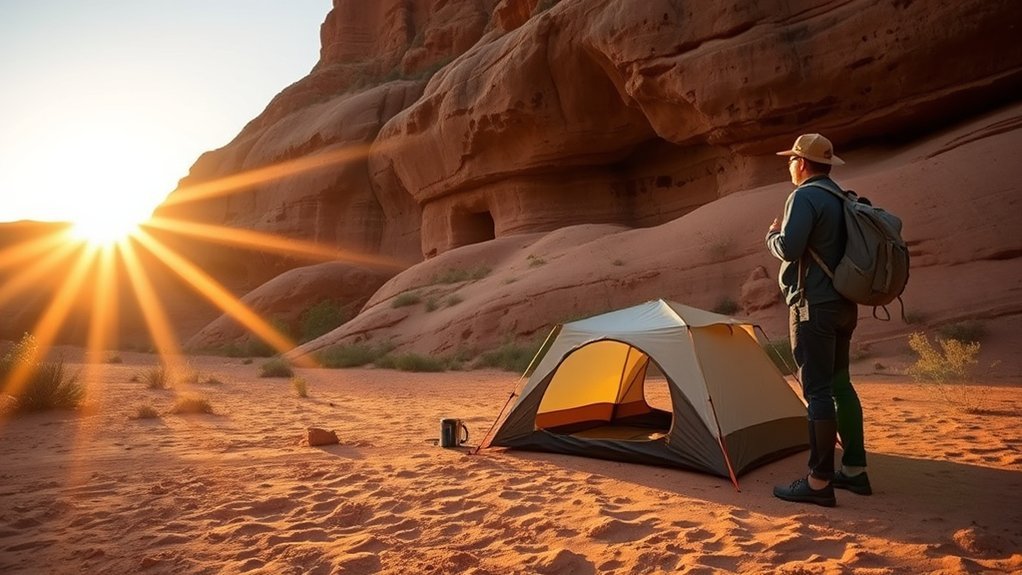
Because Canyon de Chelly sits within the Navajo Nation, you’ll need to follow local rules—get camping permission from tribal offices, hire a Navajo guide for any day hikes into the canyon, and stick to designated paths—so your visit respects both regulations and residents’ homes. Beyond permits, practice respectful travel practices: follow Leave No Trace, pack out trash, avoid disturbing artifacts, and keep noise low near dwellings. Hire a Navajo guide to learn history and access routes responsibly; guides also help you observe cultural etiquette like asking before photographing people or private structures. Familiarize yourself with Appreciate AZ principles and approach interactions with openness and humility. These steps protect the landscape, honor Navajo traditions, and make your trip meaningful and low-impact.
Frequently Asked Questions
Where to Camp Near Canyon De Chelly?
You can camp at Cottonwood and Spider Rock campgrounds or stay in Chinle; consider backcountry sites with a local guide. Follow campground options, respect camping regulations, seasonal conditions, and Navajo permit rules for safety.
What Is the Best Time of Year to Visit Canyon De Chelly?
The best season to visit is spring or fall; you’ll enjoy milder weather conditions, comfortable highs around 70–80°F in spring and cooler 60°F falls, plus wildflowers or foliage—avoid extreme summer heat and check seasonal closures.
Do You Need a Guide for Canyon De Chelly?
Yes — you’ll need a Navajo guide for most hikes; only the White House Ruins and rim trails are unguided. Guided tours enhance safety, access and canyon history, and can include jeep rides or overnight backcountry trips.
Is Canyon De Chelly Worth It?
Yes — you’ll find Canyon De Chelly worth it for its natural beauty, cultural depth, and quieter trails. You’ll hire a guide for canyon access, gain local insight, and enjoy scenic hikes, tours, and memorable photography.
Conclusion
Canyon de Chelly feels like a living storybook—visit prepared and you’ll read every page. Plan for seasons and weather, secure Navajo permits, and book guides for any backcountry trips. Choose Cottonwood or Spider Rock for managed stays, and tackle rim hikes unguided only with solid navigation and water. Pack layers, a first-aid kit, and respect cultural sites. Travel thoughtfully, follow Navajo rules, and you’ll leave richer in experience and understanding.

